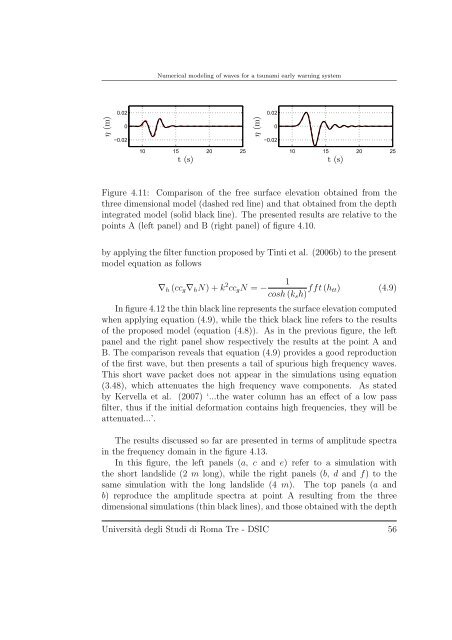Numerical modeling of waves for a tsunami early warning system
Numerical modeling of waves for a tsunami early warning system
Numerical modeling of waves for a tsunami early warning system
Create successful ePaper yourself
Turn your PDF publications into a flip-book with our unique Google optimized e-Paper software.
η (m)<br />
0.02<br />
0<br />
−0.02<br />
<strong>Numerical</strong> <strong>modeling</strong> <strong>of</strong> <strong>waves</strong> <strong>for</strong> a <strong>tsunami</strong> <strong>early</strong> <strong>warning</strong> <strong>system</strong><br />
10 15 20 25<br />
t(s)<br />
η (m)<br />
0.02<br />
0<br />
−0.02<br />
10 15 20 25<br />
t(s)<br />
Figure 4.11: Comparison <strong>of</strong> the free surface elevation obtained from the<br />
three dimensional model (dashed red line) and that obtained from the depth<br />
integrated model (solid black line). The presented results are relative to the<br />
points A (left panel) and B (right panel) <strong>of</strong> figure 4.10.<br />
by applying the filter function proposed by Tinti et al. (2006b) to the present<br />
model equation as follows<br />
∇h (ccg∇hN)+k 2 1<br />
ccgN = −<br />
cosh (ksh) fft(htt) (4.9)<br />
In figure 4.12 the thin black line represents the surface elevation computed<br />
when applying equation (4.9), while the thick black line refers to the results<br />
<strong>of</strong> the proposed model (equation (4.8)). As in the previous figure, the left<br />
panel and the right panel show respectively the results at the point A and<br />
B. The comparison reveals that equation (4.9) provides a good reproduction<br />
<strong>of</strong> the first wave, but then presents a tail <strong>of</strong> spurious high frequency <strong>waves</strong>.<br />
This short wave packet does not appear in the simulations using equation<br />
(3.48), which attenuates the high frequency wave components. As stated<br />
by Kervella et al. (2007) ‘...the water column has an effect <strong>of</strong> a low pass<br />
filter, thus if the initial de<strong>for</strong>mation contains high frequencies, they will be<br />
attenuated...’.<br />
The results discussed so far are presented in terms <strong>of</strong> amplitude spectra<br />
in the frequency domain in the figure 4.13.<br />
In this figure, the left panels (a, c and e) refer to a simulation with<br />
the short landslide (2 m long), while the right panels (b, d and f) tothe<br />
same simulation with the long landslide (4 m). The top panels (a and<br />
b) reproduce the amplitude spectra at point A resulting from the three<br />
dimensional simulations (thin black lines), and those obtained with the depth<br />
Università degli Studi di Roma Tre - DSIC 56

















